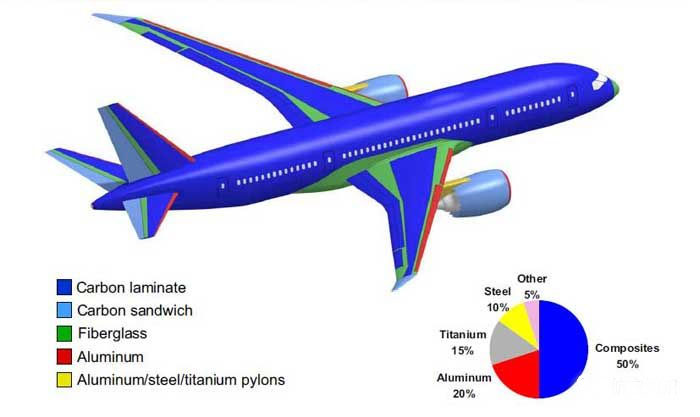
Boeing 787 uses extensive carbon fiber materials for its shell
High-performance fiber in aviation field - boron fiber
Boron fiber itself is a composite material. At present, the biggest use of boron fiber is to make composite materials with epoxy resin or aluminum for aviation and aerospace, such as pipe supports and heat dissipation/cooling plates for electronic parts: fan blades, wings Leather, landing gear, etc., engines for aircraft engines. It can also be used to manufacture advanced sports equipment such as tennis rackets, badminton rackets, fishing rods, snowboards, bicycle frames, and golf clubs. Boron has a high neutron absorption capacity and can be used to build radiation-proof shelters, nuclear waste transport barrels and vessels. Boron epoxy has unique microwave absorption and reflection capabilities and is limited to antennas and radars.
Boron fiber is one of the earliest high-performance fibers used in aviation. The U.S. Air Force Reinforcement Materials Research Laboratory first developed and developed boron fiber (M-core) with the purpose of studying lightweight, high-toughness reinforced fiber materials for cutting-edge aircraft manufacturing high-performance systems. Commercial-scale production and ongoing research are now centered at Textron Systems in the United States. Unfortunately, DuPont's Kevlar fibers don't have the same market reach as the high-performance fibers mentioned above because boron fibers are produced in smaller quantities and cost more than carbon fibers. However, boron fiber still has its place in aerospace and other fields with its unique properties. The shipping industry is mainly used for aircraft parts.

The use of boron fiber composite materials to repair aircraft has the following characteristics:
Repairs can be started without disassembling the airframe, which can shorten maintenance and grounding time and bring great benefits.
When repairing, no rivets, bolts, etc. are needed. Resin bonding can be used to repair, which can avoid cracks and stress in rivets and bolt holes.
It can be detected through non-destructive tests such as ultrasonic and eddy current, which will not cause electric shock.
It can extend fatigue life and reduce maintenance costs.
Application areas of :
Composite material molding hydraulic press is mainly suitable for molding thermosetting, thermoplastic and other plastic materials. The product size and precision requirements are high, and the frame structure is preferred.
It is widely used in transportation industries such as automobiles, aviation, and high-speed rail, as well as in home furnishing and electric power industries. It is used for the molding of SMC/BMC/DMC/GMT/LFT/PCM and other composite materials.
Performance characteristics of hydraulic press for boron fiber composite materials:
Frame/four column structure;
The frame structure has good rigidity, high stability, strong anti-eccentric load ability, and is not prone to fine deviation after adjustment;
Four-column structure with column guide, strong adjustability and high cost performance;
Fast speed and small vibration;
Separate mold opening cylinder system.


 +86-13509801050
+86-13509801050
 E-mail
E-mail
